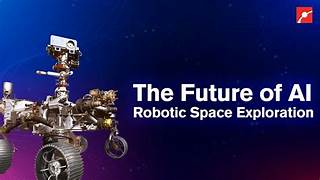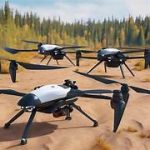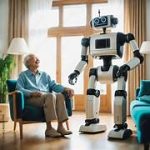AI-Powered Robots for Space Exploration: Revolutionizing the Final Frontier
Space exploration has captivated humanity for centuries, leading to remarkable discoveries about the cosmos and pushing the boundaries of what we understand about our universe. From the earliest telescopes to the Apollo missions and the Mars rovers, human ingenuity has constantly expanded our reach into the final frontier. However, as space missions become more complex and ambitious, it becomes increasingly apparent that human involvement alone is not enough. The harsh conditions of outer space, the vast distances involved, and the intricate tasks that need to be performed require a new generation of technology—AI-powered robots.
Artificial Intelligence (AI) is transforming the landscape of space exploration, with AI-driven robots playing an essential role in missions ranging from deep space exploration to surface analysis on other planets. These autonomous robots are capable of carrying out tasks that were once thought to be the exclusive domain of human astronauts. With advanced sensors, machine learning algorithms, and real-time decision-making capabilities, AI-powered robots are setting the stage for the next wave of exploration beyond Earth. This article delves into the ways AI-powered robots are revolutionizing space exploration, the technology behind them, the advantages they bring, and the future potential they hold for humanity’s quest in space.
The Role of AI in Space Exploration
AI is defined as the capability of machines to mimic human-like intelligence, including learning, reasoning, problem-solving, and decision-making. In space exploration, AI provides robots with the ability to perform these functions autonomously in environments that are challenging, remote, and often inhospitable to humans. Whether exploring distant planets, collecting data from asteroids, or performing repairs on spacecraft, AI-powered robots offer an unprecedented level of efficiency and precision. They are transforming space exploration in several ways:
1. Autonomous Navigation and Exploration
One of the key advantages of AI-powered robots in space exploration is their ability to navigate autonomously. Spacecraft and rovers with AI systems can traverse unknown terrain on distant planets, moons, and asteroids, mapping the environment, identifying potential hazards, and adjusting their course in real time. For example, NASA’s Perseverance Rover on Mars is equipped with AI that allows it to make autonomous decisions while exploring the Martian surface. The AI system helps the rover select the best path, avoiding obstacles and ensuring that it remains on course to reach its destination.
This autonomy is especially crucial for missions to far-flung locations like asteroids, moons, and outer planets where communication delays from Earth can range from several minutes to hours. The AI systems in these robots allow them to make critical decisions without waiting for instructions from mission control.
2. Data Collection and Analysis
AI-powered robots are also capable of collecting, analyzing, and processing vast amounts of data generated during space exploration. The data collected from instruments onboard spacecraft or surface rovers can be overwhelming for human scientists to analyze in real-time. AI algorithms can be used to analyze this data immediately, identifying patterns, anomalies, and important scientific insights.
For example, AI can help robotic probes assess the chemical composition of a planet’s surface, the presence of water, or the potential for microbial life. In a mission like the search for signs of life on Mars, robots can automatically analyze soil samples, detect specific molecules, and determine whether they match the characteristics of biological activity. This reduces the need for time-consuming human intervention, enabling faster scientific discoveries.
3. Precision and Efficiency in Complex Tasks
The precision and efficiency offered by AI are essential in performing complex tasks that are often required during space missions. Whether it’s assembling structures in space, conducting repairs, or even docking spacecraft, AI-powered robots can execute these tasks with a level of accuracy that minimizes the risk of errors.
AI-driven robots can also adapt to unexpected situations and challenges that might arise during a mission. For example, in a scenario where a satellite is malfunctioning, an AI-powered robot could be sent to perform repairs autonomously, utilizing diagnostic tools, sensors, and machine learning to troubleshoot the issue and fix it without human intervention.
Key Technologies Behind AI-Powered Robots in Space
Several advanced technologies work in unison to enable AI-powered robots to perform space exploration tasks. These include:
1. Machine Learning and Deep Learning
Machine learning (ML) and deep learning (DL) algorithms are at the heart of AI-driven space robots. Machine learning allows robots to learn from the data they collect and make decisions based on experience. Deep learning, a subset of machine learning, uses neural networks to process large amounts of data and recognize patterns.
For instance, deep learning models are crucial in identifying objects or anomalies in space. Whether it’s detecting signs of life on Mars or identifying asteroids that may pose a threat to Earth, deep learning algorithms enable robots to make sense of complex visual, chemical, or spatial data in real-time.
2. Computer Vision and Image Recognition
Computer vision, powered by AI, is a critical technology for space robots. Using cameras and sensors, these robots can capture high-resolution images and analyze them to identify objects, terrain features, and potential hazards. Image recognition software allows robots to “see” and interpret the environment, enabling them to make informed decisions while navigating or performing tasks.
For example, NASA’s Curiosity Rover uses computer vision to analyze images of the Martian surface, distinguishing between rocks, soil, and obstacles. The robot’s AI then uses this information to guide its movements and avoid potential dangers.
3. Natural Language Processing (NLP)
Natural Language Processing (NLP) allows robots to understand and process human language. This technology could be crucial for communication between space robots and human mission controllers. By utilizing NLP, robots can receive instructions, provide status updates, and even interact with astronauts in a way that feels intuitive and natural.
NLP could be especially helpful in future missions involving human-robot collaboration, where robots might assist astronauts by completing complex tasks autonomously while taking direction from their human counterparts.
4. Real-Time Decision-Making Algorithms
Real-time decision-making algorithms enable robots to respond to unforeseen challenges and changes in the environment quickly. In space, where communication delays with Earth can be significant, these algorithms are essential for ensuring that robots can handle unexpected situations independently.
For instance, if a space rover encounters an unexpected obstacle, the AI system will use real-time decision-making to assess the situation, devise an action plan, and carry out the necessary steps to overcome the challenge—without waiting for instructions from Earth.
Benefits of AI-Powered Robots in Space Exploration
AI-powered robots bring several advantages to space missions:
1. Cost-Effectiveness
AI-powered robots reduce the cost of space exploration by performing tasks autonomously, reducing the need for human presence and oversight. For instance, instead of sending astronauts to perform tedious or dangerous tasks, robots can be deployed to complete these jobs with greater efficiency and at a lower cost. Additionally, robots can carry out data analysis in real-time, streamlining the overall mission timeline and reducing costs.
2. Safety and Risk Reduction
Space exploration is inherently dangerous, with astronauts facing numerous risks from radiation, microgravity, and the unknown conditions of space environments. By relying on robots for tasks such as exploration, repairs, and data collection, space agencies can minimize human exposure to hazardous environments. Robots can be sent to dangerous locations such as volcanic surfaces or radiation-rich zones without putting human lives at risk.
3. Enhanced Exploration Capabilities
AI-powered robots extend the reach of human exploration by enabling missions to more distant and hostile locations. These robots can be deployed to places that are far beyond human capability, such as deep space missions, asteroid exploration, and planetary surfaces like Venus or the icy moons of Jupiter. With their advanced autonomy, robots can explore without the need for direct human involvement, significantly expanding our scientific understanding of the universe.
The Future of AI-Powered Robots in Space Exploration
The future of AI-powered robots in space exploration is limitless. As technology continues to advance, robots will become increasingly capable of performing complex and precise tasks in a variety of space environments. Some potential developments include:
- Human-Robot Collaboration: In the near future, AI-powered robots could work alongside human astronauts in space, providing support in hazardous environments and assisting with tasks like assembling space stations, conducting scientific experiments, or performing extravehicular activities (EVA).
- Autonomous Spacecraft: AI-powered spacecraft could navigate autonomously through space, identifying and avoiding hazards, conducting research, and returning valuable data to Earth without human intervention.
- Long-Term Space Colonization: As humans look toward establishing colonies on the Moon or Mars, AI-powered robots could be crucial for building infrastructure, conducting mining operations, and ensuring the sustainability of human habitats in space.
- Interstellar Exploration: AI-powered robots may one day enable humanity’s first interstellar missions. These robots could be sent to explore planets and stars beyond our solar system, gathering data that would be impossible for humans to retrieve.
Conclusion
AI-powered robots are revolutionizing space exploration by making missions safer, more efficient, and more cost-effective. Through autonomous navigation, real-time decision-making, and advanced data analysis, these robots are enabling humanity to explore the farthest reaches of the cosmos. With continued advancements in AI, the future of space exploration looks brighter than ever, promising new discoveries and opportunities that will shape the next era of space exploration.


